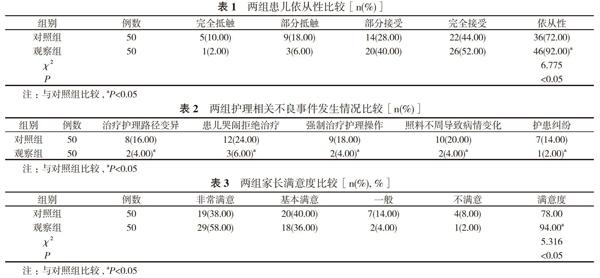肢體語(yǔ)言溝通在小兒護(hù)理中的應(yīng)用效果分析
馬博

【摘要】 目的 研究肢體語(yǔ)言溝通在小兒護(hù)理中的應(yīng)用效果。方法 100例二科門診就診患兒, 按照入院先后順序分為對(duì)照組與觀察組, 各50例。對(duì)照組患兒應(yīng)用常規(guī)護(hù)理, 觀察組患兒在對(duì)照組基礎(chǔ)上應(yīng)用肢體語(yǔ)言溝通。比較兩組患兒依從性、護(hù)理相關(guān)不良事件發(fā)生情況及家長(zhǎng)滿意度。結(jié)果 觀察組患兒依從性為92.00%, 明顯高于對(duì)照組的72.00%, 差異具有統(tǒng)計(jì)學(xué)意義(P<0.05)。觀察組治療護(hù)理路徑變異、患兒哭鬧拒絕治療、強(qiáng)制治療護(hù)理操作、照料不周導(dǎo)致病情變化、護(hù)患糾紛發(fā)生率均明顯低于對(duì)照組, 差異具有統(tǒng)計(jì)學(xué)意義(P<0.05)。觀察組家長(zhǎng)滿意度為94.00%, 明顯高于對(duì)照組的78.00%, 差異具有統(tǒng)計(jì)學(xué)意義(P<0.05)。結(jié)論 肢體語(yǔ)言溝通應(yīng)用于患兒護(hù)理中有助于依從性、家長(zhǎng)滿意度的提高, 可減少護(hù)理相關(guān)不良事件發(fā)生, 具有較高的臨床推廣應(yīng)用價(jià)值。
【關(guān)鍵詞】 兒科;肢體語(yǔ)言溝通;依從性;不良事件;滿意度
DOI:10.14163/j.cnki.11-5547/r.2019.22.070
【Abstract】 Objective ? To study the application effect of body language communication in pediatric nursing. Methods ? A total of 100 children in pediatric outpatient clinic were divided by admission order into control group and observation group, with 50 cases in each group. The control group received conventional nursing, and the observation group received body language communication on the basis of the control group. The compliance, occurrence of nursing related adverse events and degree of parental satisfaction were compared in two groups. Results ? The observation group had obviously higher compliance as 92.00% than 72.00% in the control group, and the difference was statistically significant (P<0.05). The observation group had obviously lower incidence of variation of treatment and nursing pathway, crying refusal of treatment for children, compulsory treatment and nursing operation, poor care leading to changes in the condition of disease, and nurse-patient disputes than the control group, and the difference was statistically significant (P<0.05). The observation group had obviously higher degree of parental satisfaction as 94.00% than 78.00% in the control group, and the difference was statistically significant (P<0.05). Conclusion ? The application of body language communication in childrens nursing can help improve compliance and degree of parental satisfaction, and reduce the occurrence of nursing-related adverse events. It contains high clinical promotion and application value.
【Key words】 Pediatric department; Body language communication; Compliance; Adverse events; Satisfaction degree
兒科是醫(yī)院護(hù)理投訴率、護(hù)患糾紛發(fā)生率均較高的科室之一[1, 2], 小兒會(huì)因身體不適、環(huán)境陌生等情況出現(xiàn)不良情緒, 對(duì)治療和護(hù)理存在抗拒心理, 加上小兒的溝通、配合能力均較差[3], 且無(wú)法準(zhǔn)確表達(dá)自己感受, 自主意識(shí)不強(qiáng), 對(duì)醫(yī)院治療及護(hù)理的順利開展產(chǎn)生了不良影響, 因此對(duì)護(hù)理工作的要求越來(lái)越高。通過與小兒有效溝通, 可促進(jìn)其依從性提高, 故在小兒護(hù)理中應(yīng)選擇合適的溝通方法。本文研究肢體語(yǔ)言溝通在小兒護(hù)理中的應(yīng)用效果, 現(xiàn)報(bào)告如下。
1 資料與方法
1. 1 一般資料 選取本院2017年8月~2018年7月兒科門診就診的100例患兒作為研究對(duì)象, 納入標(biāo)準(zhǔn):①病情輕微患兒;②患兒可在家長(zhǎng)幫助下接受護(hù)理。排除標(biāo)準(zhǔn):①手足口病患兒;②存在先天性疾病、器質(zhì)性病變患兒;③監(jiān)護(hù)人不明確, 或家長(zhǎng)不同意參與本次研究。將患兒按照入院先后順序分為對(duì)照組與觀察組, 各50例。對(duì)照組患兒男27例, 女23例;年齡1~5歲, 平均年齡(3.20±1.02)歲。觀察組患兒男26例, 女24例;年齡1~6歲, 平均年齡(3.30±1.08)歲。兩組患兒一般資料比較, 差異無(wú)統(tǒng)計(jì)學(xué)意義(P>0.05), 具有可比性。

